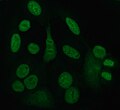Antinuclear antibody: Difference between revisions
CSV import |
CSV import |
||
| Line 12: | Line 12: | ||
File:LECell.jpg|LE Cell | File:LECell.jpg|LE Cell | ||
</gallery> | </gallery> | ||
== Antinuclear Antibody == | |||
Antinuclear antibodies (ANAs) are autoantibodies that bind to contents of the cell nucleus. They are often found in patients with autoimmune diseases, but can also be present in healthy individuals. ANAs are a hallmark of [[systemic lupus erythematosus]] (SLE) and are also associated with other autoimmune conditions such as [[rheumatoid arthritis]], [[scleroderma]], and [[Sjogren's syndrome]]. | |||
== Structure and Function == | |||
Antinuclear antibodies target various nuclear components, including [[DNA]], [[RNA]], and nuclear proteins. These antibodies can be directed against specific nuclear antigens such as [[histones]], [[ribonucleoproteins]], and [[centromeres]]. The presence of ANAs can lead to the formation of immune complexes that deposit in tissues, causing inflammation and damage. | |||
== Clinical Significance == | |||
The presence of ANAs is a key diagnostic marker for autoimmune diseases. The [[antinuclear antibody test]] is commonly used to screen for autoimmune disorders. A positive ANA test indicates the presence of these antibodies, but it is not specific to any one disease. Therefore, further testing is often required to determine the specific type of autoimmune disorder. | |||
=== Systemic Lupus Erythematosus === | |||
In SLE, ANAs are present in more than 95% of patients. The most common pattern seen in ANA testing for SLE is the homogeneous pattern, which indicates antibodies against [[double-stranded DNA]] and [[histones]]. | |||
=== Other Autoimmune Diseases === | |||
ANAs are also found in other autoimmune diseases. In [[scleroderma]], ANAs may show a nucleolar pattern, while in [[Sjogren's syndrome]], they may show a speckled pattern. In [[rheumatoid arthritis]], ANAs are less common but can still be present. | |||
== Testing and Interpretation == | |||
The ANA test is performed using [[immunofluorescence]] or [[enzyme-linked immunosorbent assay]] (ELISA). The immunofluorescence method involves incubating patient serum with cells fixed on a slide and then using a fluorescent dye to detect bound antibodies. The pattern and intensity of fluorescence are used to interpret the results. | |||
=== Patterns === | |||
Different staining patterns can be observed in ANA testing, including homogeneous, speckled, nucleolar, and centromere patterns. Each pattern can be associated with different types of autoantibodies and diseases. | |||
=== Titer === | |||
The ANA titer is a measure of the concentration of antinuclear antibodies in the blood. A higher titer indicates a greater concentration of antibodies. Titers are reported as ratios, such as 1:160 or 1:320, with higher numbers indicating higher levels of antibodies. | |||
== Related Pages == | |||
* [[Autoimmune disease]] | |||
* [[Systemic lupus erythematosus]] | |||
* [[Rheumatoid arthritis]] | |||
* [[Scleroderma]] | |||
* [[Sjogren's syndrome]] | |||
* [[Immunofluorescence]] | |||
{{Autoimmune diseases}} | |||
[[Category:Autoimmune diseases]] | |||
[[Category:Immunology]] | |||
Latest revision as of 00:38, 19 February 2025
Antinuclear_antibody[edit]
-
Main antinuclear antibody patterns on immunofluorescence
-
DsDNA antibodies
-
SSA SSB ANA
-
ANA - dsDNA antibody
-
Centromere
-
ANA Kit
-
ANA Immunofluorescence
-
ANA Nucleolar
-
Crithidia
-
LE Cell
Antinuclear Antibody[edit]
Antinuclear antibodies (ANAs) are autoantibodies that bind to contents of the cell nucleus. They are often found in patients with autoimmune diseases, but can also be present in healthy individuals. ANAs are a hallmark of systemic lupus erythematosus (SLE) and are also associated with other autoimmune conditions such as rheumatoid arthritis, scleroderma, and Sjogren's syndrome.
Structure and Function[edit]
Antinuclear antibodies target various nuclear components, including DNA, RNA, and nuclear proteins. These antibodies can be directed against specific nuclear antigens such as histones, ribonucleoproteins, and centromeres. The presence of ANAs can lead to the formation of immune complexes that deposit in tissues, causing inflammation and damage.
Clinical Significance[edit]
The presence of ANAs is a key diagnostic marker for autoimmune diseases. The antinuclear antibody test is commonly used to screen for autoimmune disorders. A positive ANA test indicates the presence of these antibodies, but it is not specific to any one disease. Therefore, further testing is often required to determine the specific type of autoimmune disorder.
Systemic Lupus Erythematosus[edit]
In SLE, ANAs are present in more than 95% of patients. The most common pattern seen in ANA testing for SLE is the homogeneous pattern, which indicates antibodies against double-stranded DNA and histones.
Other Autoimmune Diseases[edit]
ANAs are also found in other autoimmune diseases. In scleroderma, ANAs may show a nucleolar pattern, while in Sjogren's syndrome, they may show a speckled pattern. In rheumatoid arthritis, ANAs are less common but can still be present.
Testing and Interpretation[edit]
The ANA test is performed using immunofluorescence or enzyme-linked immunosorbent assay (ELISA). The immunofluorescence method involves incubating patient serum with cells fixed on a slide and then using a fluorescent dye to detect bound antibodies. The pattern and intensity of fluorescence are used to interpret the results.
Patterns[edit]
Different staining patterns can be observed in ANA testing, including homogeneous, speckled, nucleolar, and centromere patterns. Each pattern can be associated with different types of autoantibodies and diseases.
Titer[edit]
The ANA titer is a measure of the concentration of antinuclear antibodies in the blood. A higher titer indicates a greater concentration of antibodies. Titers are reported as ratios, such as 1:160 or 1:320, with higher numbers indicating higher levels of antibodies.
Related Pages[edit]
- Autoimmune disease
- Systemic lupus erythematosus
- Rheumatoid arthritis
- Scleroderma
- Sjogren's syndrome
- Immunofluorescence
| Hypersensitivity and autoimmune diseases (279.5–6) | ||||||||||||||||
|---|---|---|---|---|---|---|---|---|---|---|---|---|---|---|---|---|
|









